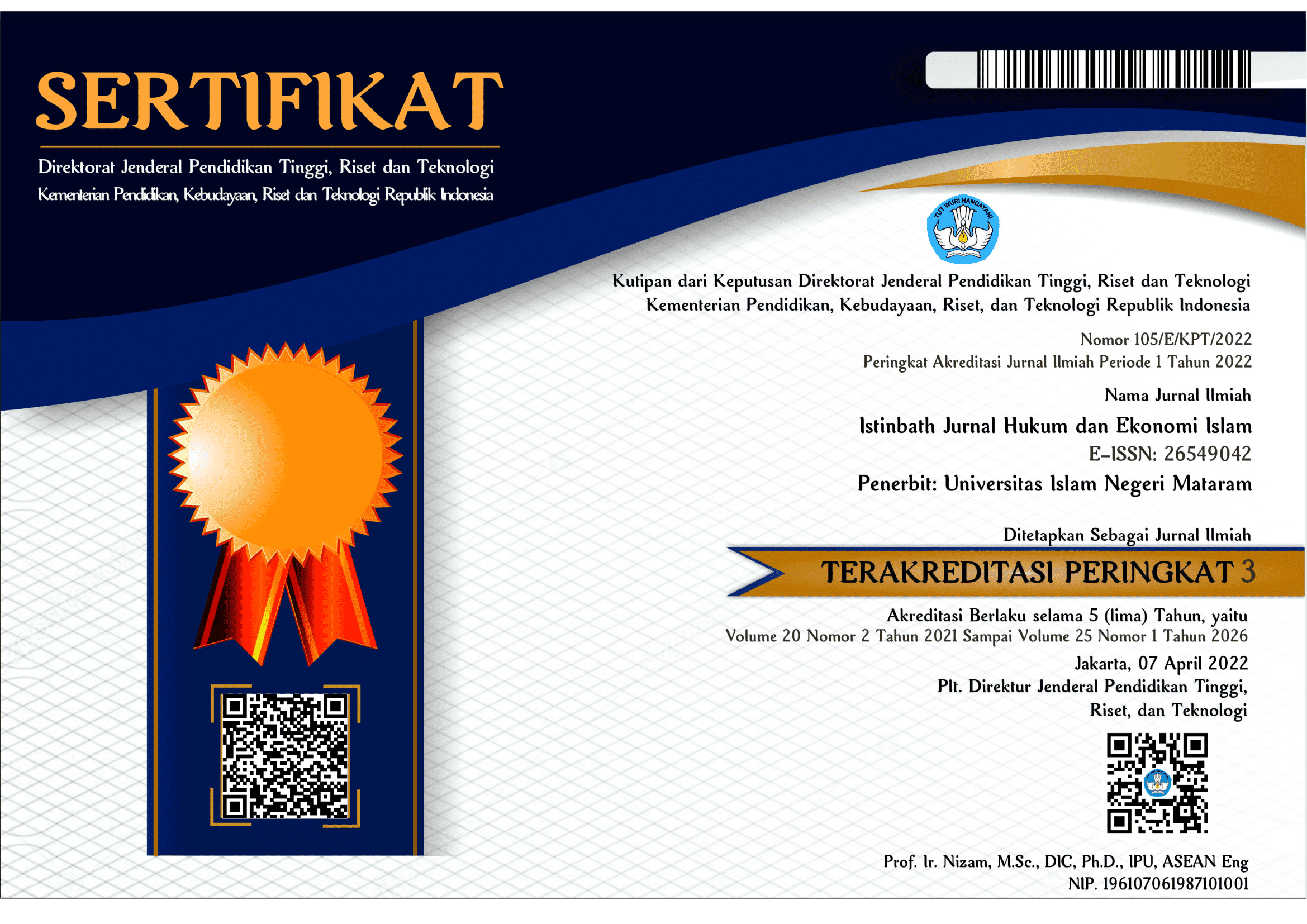NISTA MARRIAGE PRACTICES AT THE LOWEST MARRIAGE LEVEL URF PERSPECTIVE IN PEGAYAMAN SUKASADA VILLAGE, BULELENG, BALI
DOI:
https://doi.org/10.20414/ijhi.v23i1.708Keywords:
'urf, nista marriage, pegayaman village, marriage levelAbstract
The research method used in this research is qualitative research, a descriptive study type. The researcher uses qualitative research methods to obtain, study, and understand the phenomenon through in-depth data regarding the community's perspective on the practice of nista marriages in Pegayaman Village, Sukasada, Buleleng, Bali. This type of research uses descriptive research to explain and examine the phenomenon of nista marriages in Pegayaman Village from an 'Urf perspective. The researcher's data collection techniques are observation, documentation and interviews with informants from three categories, including other key informants from local community leaders, primary informants who are residents, and complementary informants who are migrants who live in the village and work in the village office. People in Bali use levels as identities according to their position, especially the Hindu population, which starts from the highest Brahmana, Ksatria, Waisya, and Sudra, the lowest caste.
In contrast to the community in Pegayaman, where the majority of the population is Muslim, the level is implemented within the scope of marriage. Local traditions, empowerment, and community perceptions regarding nista marriages are the benchmarks for researchers analysing ancestral heritage from an Urf perspective. Binary opposition is used to explore the relationship between Islamic teachings and ancestral cultural heritage. The existence of 'Urf about Islamic teachings is the basis for the empirical facts of nista marriages in Pegayaman village. In studying the data obtained by researchers regarding slanderous marriages from the perspective of 'urf, it is limited to 'urf fasid, namely in nista marriages as the lowest level of marriage, which is contrary to the law and enriches the elements of family formation.
References
Arifandi, F. (2018). Saat Tradisi menjadi Dalil.
Bahrudin, M. (2019). Ilmu Ushul Fiqh.
Baiti, R. and R. A. (2014). Teori dan Proses Islamisasi di Indonesia. Jurnal Wardah, 15(2), 133–145. https://doi.org/https://doi.org/10.19109/wardah.v15i2.193
Basri, R. (2019). Ushul Fiqh 1 (Ashudi, Ed.; Pertama). IAIN Parepare Nusantara Press.
Database Peraturan. (1974). Undang-undang (UU) Nomor 1 Tahun 1974 tentang Perkawinan. https://peraturan.bpk.go.id/Details/47406/uu-no-1-tahun-1974
Daud, F. K., Al, I., Tuban, H., Wahyu, R., Uin, S., Gunung, S., & Bandung, D. (2021). Otoritas Wali Nikah Dalam Islam: Analisis Perkawinan Tanpa Wali di Indonesia Perspektif Fiqh dan Hukum Positif. Akademika (Jurnal Studi Islam), 15(2), 148–169. https://doi.org/https://doi.org/10.30736/adk.v15i2.544
Drs. Muhammad Suharto. (2023, December 27). Wawancara Tokoh Masyarakat Desa Pegayaman.
Effendi, E. (2020). Penggunaan Wali hakim, dalam Pernikahan (Studi Kasus di Kua Kecamatan Cengkareng Jakarta Barat). Mozaic: Islam Nusantara , 6(1). https://doi.org/https://doi.org/10.47776/mozaic.v6i1.156
Furqan, M. (2022). Kedudukan ’Urf sebagai Sumber Hukum dalam Madzhab Syafi’i. Jurnal Al-Nadhair, 1(2), 73–92. https://doi.org/https://doi.org/10.61433/alnadhair.v1i2.9
Harisudin, M. N. (2016). ’Urf sebagai Sumber Hukum Islam (Fiqh) Nusantara. Jurnal Al-Fikr, 26(1), 66–86. https://doi.org/https://doi.org/10.24252/jumdpi.v20i1.2311
Hasan, A. (2021). Pandangan ’Urf terhadap Uang Pekhanjangan dalam Perkawinan Melangkahi Kakak Kandung. Istinbath; Jurnal Hukum Dan Ekonomi Islam, 20(1), 176–188. http://www.istinbath.or.id
Ibnu Majah. (2023). Kitab Sunan Ibnu Majah. Maktabah Syamilah.
Jamaluddin and Amalia, N. (2016). Buku Ajar HUKUM PERKAWINAN.
Khoiruddin, M. A. (2016). Agama dan Kebudayaan Tinjauan Studi Islam. TRIBAKTI: Jurnal Pemikiran Keislaman LP3M IAI-Tribakti, 26(1), 118–134. https://doi.org/https://doi.org/10.33367/tribakti.v26i1.206
Khusairi, H., & Mandala, I. (2022). Perkawinan Adat: Analisis Hukum dan Sistem Perkawinan di Kerinci dalam Perspektif Hukum Islam. Istinbath; Jurnal Hukum Dan Ekonomi Islam, 21(2), 227–242. https://doi.org/https://doi.org/10.20414/ijhi.v21i2.565
Masyarakat Desa Pegayaman. (2023). Hasil Pengisian Kuesioner.
Muhabarah, S. (2023, January 3). Wawancara Masyarakat Desa Pegayaman.
Mustofa. (2019). Hukum Adat Implikasi dan Aplikasinya dalam Istinbath Hukum di Indonesia Perspektif Universitas dan Lokalitas. Jurnal Varia Hukum, 1(2), 267–288. https://scholar.google.co.id/citations?view_op=view_citation&hl=id&user=CB_V4wUAAAAJ&citation_for_view=CB_V4wUAAAAJ:9ZlFYXVOiuMC
Mutmainnah, D. (2023, January 3). Wawancara Masyarakat Desa Pegayaman.
Musyafah, A. A.(2020, November). Perkawinan dalam Perspektif Filosofis Hukum Islam. JURNAL CREPIDO.2(2). 111 – 122 ttps://ejournal2.undip.ac.id/index.php/crepido/
Nasution, A. F. (2023). Metode Penelitian Kualitatif. CV Harfa Creative
Nusantara, T. B. (2020). Tradisi “Merangkat” dalam pernikahan Perspektif ’Urf [UIN Maulana Malik Ibrahim]. http://etheses.uin-malang.ac.id/21363/6/15210038.pdf
Rahmawati, T. (2021). FIQH MUNAKAHAT 1 (DARI PROSES MENUJU PERNIKAHAN HINGGA HAK DAN KEWAJIBAN SUAMI ISTRI) (Pertama). Duta Media Publishing.
Raudah, S. (2023). Wawancara Masyarakat Desa Pegaayaman.
Ridwan, M. (2021). Penguatan Diskursus Keislaman Kontemporer Untuk Mahasiswa Perguruan Tinggi Umum (Ulfa, Ed.; Pertama). Zahir Publishing.
Rijal, O. :, & Zionis, M. (2011). Posisi Al-’Urf dalam Struktur Bangunan Hukum Islam. Jurnal Falasifa, 2(2), 131–150.
Rita Fiantika, F., Wasil, M., & Jumiyati, S. (2022). Metodologi Penelitian Kualitatif (Y. Novita, Ed.; Pertama). PT. Global Eksekutif Teknologi. www.globaleksekutifteknologi.co.id
Rizal, F. (2019). Penerapan ’Urf sebagai Metode dan Sumber Hukum Ekonomi Islam. Al-Manhaj: Jurnal Hukum Dan Pranata Sosial Islam, 1(2), 155–176. https://doi.org/https://doi.org/10.37680/almanhaj.v1i2.167
Rosyadi, I. (2005). Kedudukan Al’Addah wa Al-’Urf dalam membangun Hukum Islam. Suhuf, 17(1), 3–12. https://doi.org/http://hdl.handle.net/11617/854
Saputra, H. H. (2020). Penentu Akad Nikah dengan Tradisi Perhitungan Weton dan Pengaruhnya terhadap Keharmonisan Rumah Tangga (Studi di Kecamatan Kalirejo Kabupaten lampung Tengah) [UIN Raden Intan Lampung]. http://repository.radenintan.ac.id/11468/2/hendri%20husin.pdf
Sarwat, A. (2021). Seri Fiqih Kehidupan Pernikahan (Fatih, Ed.; Keempat). Rumah Fiqih Publishing.
Suwarjin. (2012). Ushul Fiqh (M. Dahlan, Ed.; Pertama). Penerbit Teras.
Waluyo, B. (2020). Sahnya Perkawinan Menurut Undang - Undang Nomor 1 Tahum 1974 tentang Perkawinan. Jurnal Media Komunikasi Pendidikan Pancasila Dan Kewarganegaraan, 2(1), 193–199. https://doi.org/https://doi.org/10.23887/jmpppkn.v2i1.135
Wayan Imam Muhajirin. (2023, December 27). Wawancara Tokoh Masyarakat Desa Pegayaman.
Yudowibow, S. (2012). Tinjauan Hukum Perkawinan di Indonesia terhadap Konsep Kafa’ah dalam Hukum Perkawinan Islam. Jurnal Yustisia Indonesia, 1(2), 98–109. https://doi.org/https://doi.org/10.20961/yustisia.v1i2.10632
Zubaidi, Z., & Kamaruzzaman. (2018). Perpindahan Wali Nasab Kepada Wali Hakim (Analisis Terhadap Sebab-Sebab ‘Aḍal Wali Pada KUA Kecamatan Syiah Kuala Kota Banda Aceh). El-Usrah: Jurnal Hukum Keluarga, 1(1), 93–108. https://doi.org/http://dx.doi.org/10.22373/ujhk.v1i1.5568
Downloads
Published
Issue
Section
License
Copyright (c) 2024 Atika Agustina Tarik, Thoat Stiawan, Mohammad Ikhwanuddin

This work is licensed under a Creative Commons Attribution-ShareAlike 4.0 International License.





